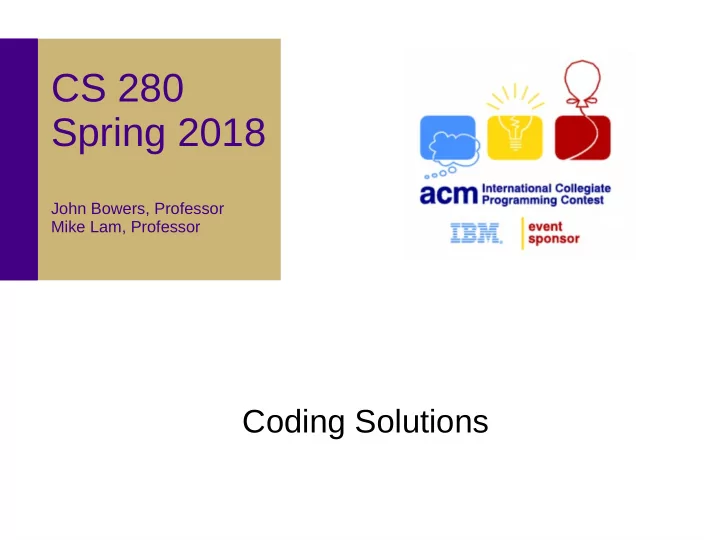

CS 280 Spring 2018 John Bowers, Professor Mike Lam, Professor Coding Solutions
Solving problems ● Understand the problem ● Categorize the problem ● Design a solution ● Code the solution ● Debug the solution
Solving problems ● Understand the problem ● Categorize the problem ● Design a solution ● Code the solution (today's focus) ● Debug the solution
Coding solutions ● Keep your files organized – Subfolder for each problem you solve ● Use the automated test framework – Or run interactively for quick tests ● Learn and customize your editor – Syntax highlighting, line numbers – Automatic indentation, tabs/spaces preferences – Key combinations, search/replace ● Practice typing! – Goal: speed AND precision
Coding solutions ● Write I/O code first – Can help you understand the problem better – Gives you a psych boost (got something working!) – You can't test anything without getting I/O right ● Programming contest I/O – Copy sample input/output from problem description – Read from standard input ( System.in ) – Write to standard output ( System.out ) – Use standard error for debugging output ( System.err ) – Output usually must match expected output EXACTLY !!!
I/O patterns ● Common input patterns – Number of cases given – Stop at signal value – Multiple data sets – Multiple values per line – Integers and floating-point numbers ● Common output patterns – Single answer – Multiple quantities – Floating-point (must be accurate to X digits)
Number of cases given Scanner in = new Scanner(System.in); int n = in.nextInt(); // data count in.nextLine(); // discard newline for (int i = 0; i < n; i++) { int x = in.nextInt(); // next number in.nextLine(); // discard newline ...
Stop at signal value Scanner in = new Scanner(System.in); int x = in.nextInt(); // next number in.nextLine(); // discard newline while (x != 0) { x = in.nextInt(); // next number in.nextLine(); // discard newline ...
Multiple data sets Scanner in = new Scanner(System.in); int n = in.nextInt(); // next data count in.nextLine(); // discard newline while (n != 0) { for (int i = 0; i < n; i++) { int x = in.nextInt(); // next number in.nextLine(); // discard newline // TODO: do something with x here } n = in.nextInt(); // next data count in.nextLine(); // discard newline ...
More input patterns Scanner in = new Scanner(System.in); // read whitespace-separated line and parse into array String[] data = in.nextLine().split(“\\s+”); // convert first item to integer int x = Integer.parseInt(data[0]); // convert second item to floating-point double y = Double.parseDouble(data[1]);
Formatting output // single integer System.out.printf("%d", x); // multiple integers, padded to six characters each System.out.printf("%6d %6d", x, y); // float with two decimal digits System.out.printf("%.2f", x); // float with two decimal digits, padded to 8 chars System.out.printf("%8.2f", x); References: https://docs.oracle.com/javase/tutorial/java/data/numberformat.html ● https://www.cs.colostate.edu/~cs160/.Summer16/resources/Java_printf_method_quick_reference.pdf ●
Solved problem
Solved problem
Solved problem
Recommend
More recommend